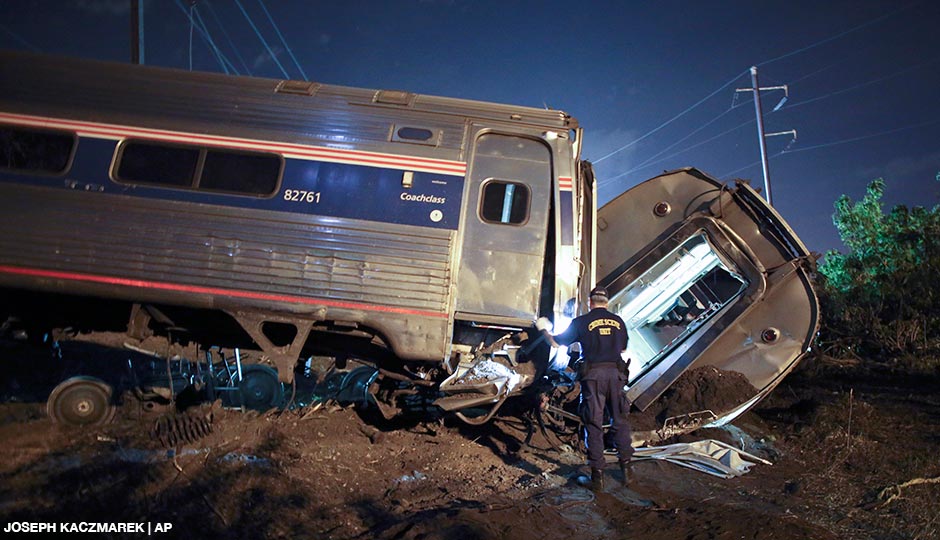5 Takeaways From the Big Amtrak Derailment Story in the New York Times Magazine

Emergency personnel work the scene of a deadly train wreck, Tuesday, May 12, 2015, in Philadelphia. An Amtrak train headed to New York City derailed and crashed in Philadelphia.
The New York Times Magazine today has unveiled a long story examining last spring’s Amtrak derailment, the crash of train 188 at Philadelphia’s Frankford Junction that killed eight people and injured more than 200 others.
The story comes just days before the National Transportation Safety Board releases a preliminary report that contains much of the data gathered in the investigation of the accident; the agency’s formal ruling on the cause is likely to come later this spring. The basic cause is known — the train was traveling well in excess of the posted speed limit when it hit a sharp curve at Frankford Junction. But why did that happen?
The Times story, written by Matthew Shaer, doesn’t offer a definitive conclusion, though it offers several possibilities. Here are some takeaways from the story.
1. The Northeast Corridor isn’t just hugely busy; it’s also a tricky challenge for railroad engineers.
The route “juts and weaves and doglegs with exhausting regularity,” Shaer writes. “It’s start, stop and start again,” one engineer told him. “You’re constantly on guard; you’re constantly trying to think one step ahead.”
It gets even more complicated in the area of Philadelphia where the accident happened. The maneuvers that must be accomplished: “Speed up out of North Philadelphia Station; slow for a gradual curve at North Second Street; throttle open again for the straightaway, where the speed limit is 70 m.p.h.; and dump speed for the sharp 50-m.p.h. curve.”
All of that is complicated enough without one other phenomenon: “Getting rocked” in urban centers, when trespassers throw objects at trains for sport. “Everyone in the Northeast has stories about it,” the veteran engineer told Shaer. “After a while, the only ones that stand out are the instances where it’s really crazy, like a railroad spike used as a harpoon, or something.”
2. Despite that level of attention, Amtrak engineers were being asked in 2015 to work more with less rest.
The agency had previously given engineers an average break of 2.5 hours between runs, Shaer writes, but was whittling that down to less than 90 minutes. One engineer wrote to complain. “Forcing shorter breaks, day after day, between runs increases fatigue-related risk and the potential for loss of focus,” he wrote. Engineers say the Washington-to-New York-and-back route was one of those affected.
3. In fact Brandon Bostian, the engineer on Amtrak 188, was reportedly “frazzled” after the first leg of his trip from New York to Washington.
A key piece of equipment failed during that leg, and the train was a half-hour late arriving in D.C. That left Bostian with little rest time before he was required to turn around and head back north.
4. Investigators still seem genuinely confused about how the accident happened.
Among the problems eliminated as causes: Faulty signal boxes, track anomalies, locomotive problems, computer glitches, collision with another train, car, or truck. Bostian took blood tests that proved he did not have drugs or alcohol in his system, and his phone records suggest he wasn’t distracted by his own communications at the time.
5. One theory? Bostian got “rocked.”
“To me, it’s pretty clear what happened,” a veteran investigator says near the end of the story. “Bostian’s got the throttle open to get the train up to speed. A projectile hits the windshield. Now the windshields on these locomotives are thick, but that impact is going to be out of nowhere and scary. As a human, you’ve got a tendency to duck. But he ducks into the dashboard and smacks his head, knocks himself out. And by the time he’s back up, and he’s reoriented himself, it’s: ‘Oh, crap.’ ” (You’ll remember that Philly Mag reported on speculation about debris striking trains at the time of the accident.)
Alternatively? Shaer posits it’s possible that Bostian got distracted by a railroading form of “highway hypnosis,” and was disoriented long enough for the accident to happen.
The Times story is online now. It appears in print in Sunday’s newspaper.
Follow @JoelMMathis on Twitter.


